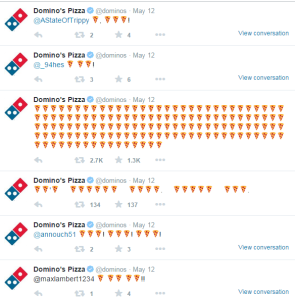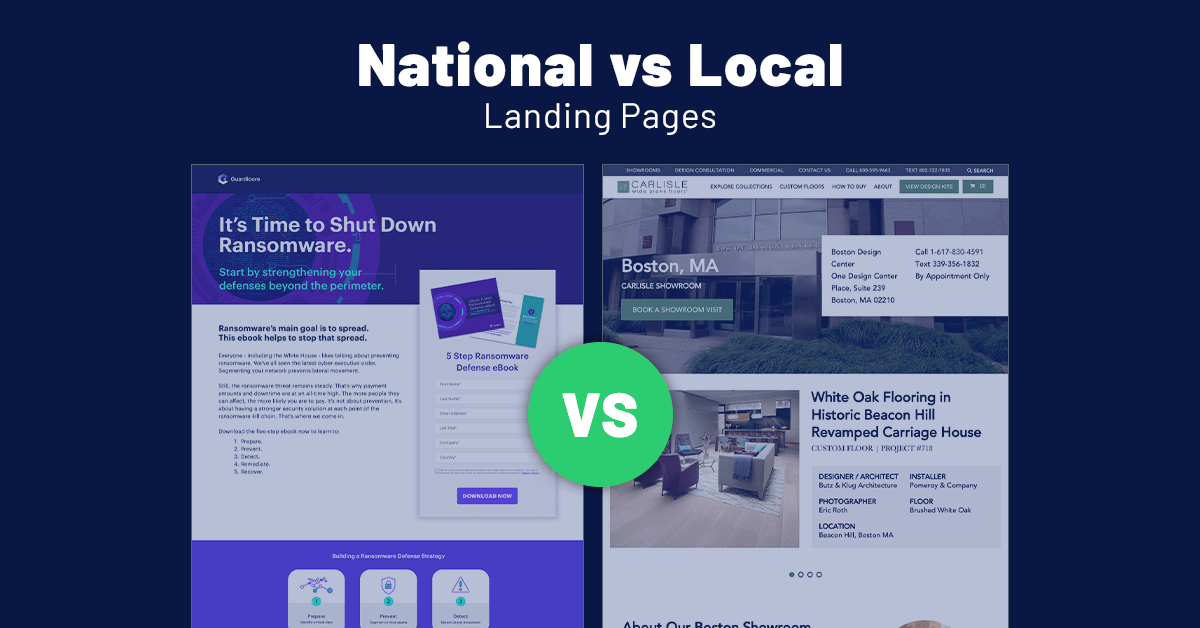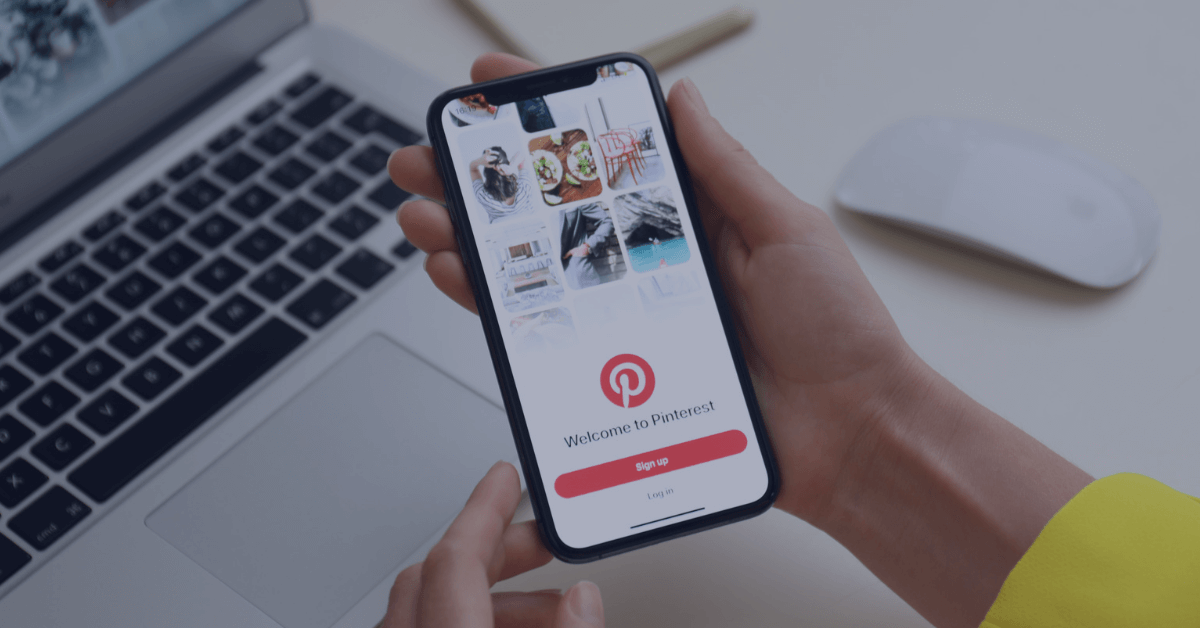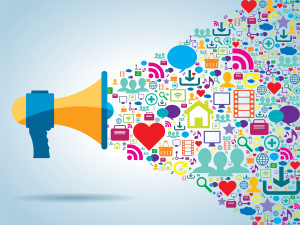
“There are nearly 2 billion smartphone users worldwide, and 41.5 billion messages and 6 billion emoticons or stickers are sent around the world every day on mobile messaging apps”- data from eMarketer and Swift Media
Last week we talked about the history of Emojis and why they are so popular in our social communications. This week we will look at how businesses are making emojis popular in marketing.
Why You Should Use Emojis
If your audience falls within those 2 billion smartphone users, integrating emojis, emoticons, or stickers in your social media can be a great way to connect with them. Using those characters can allow you to:
-
- Speak the language of your audience. Show your audience that you are in tune with them, and make yourself more relatable. As linguistics professor and seminar faculty at Columbia University, John McWhorter, told Digiday: “No human being would ever just utter that sentence like a robot…Emojis get across that human aspect of communication.”
-
- Get your message across in a creative way. Emojis are fun and using them is an expressive way for brands to stand out.
- Use fewer words. They say a picture is worth a 1,000 words. When your words are limited by a handheld screen and short attention span, keeping texts short and engaging will help your audience read your messages more easily.
When You Should (and Shouldn’t) Use Emojis
A lot of brands have been using emojis in their communications for a while now. Some received positive feedback, while others got a lukewarm response. So before infusing emojis into your next tweet, be sure to consider the following questions:
-
-
- Do you know your audience? Who are your customers and how do they communicate? If your audience is not using emojis regularly in their communications will they understand and like it if you use them? (Note: emojis are not only for millennials)
-
-
-
- How is your brand perceived? If you are a B2B organization or operating in the healthcare, financial or government industries, emojis may not be the best fit for your brand persona.
-
-
-
- Is the use of an emoji appropriate for this particular communication? What tone are you trying to convey with this message? Serious or solemn messages may be better expressed without the emoji.
-
-
- Can you find a way to give the emoji a purpose other than being decorative? Show how creative you can be by giving your emoji some functionality (see Domino and WWF example below).
Examples of Successful Emoji-Based Marketing Campaigns
- Coca-Cola: #ShareaCoke
Coca-Cola and American ad agency Wieden + Kennedy recently partnered with Twitter to create the platform’s first branded sticker featuring a pair of clinking Coke bottles. Coca-Cola asked its users to help them set a world record for the world’s largest cheers.
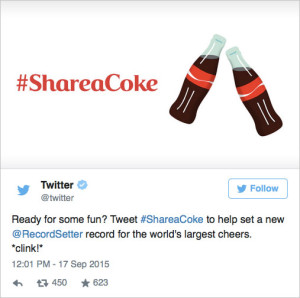
Results: Coca-Cola set a record for the “World’s Largest Cheers”. #ShareaCoke recorded more than 170,500 mentions globally.
- WWF: #EndangeredEmoji
Last May, WWF and Wieden + Kennedy London launched the #EndangeredEmoji campaign in preparation for Endangered Species Day (May 15, 2015).
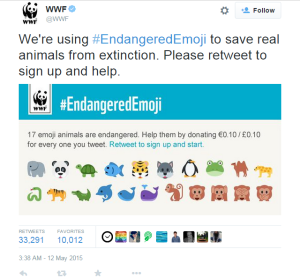
Results: 559,000 mentions and 59,000 signups since its launch in May
Although the campaign was successful in raising awareness for WWF’s cause, some influential Twitter users passed the wrong directions on to their followers. One misdirection by an influential user resulted in 31,000 possible missed signatures by excluding the call to action for twitter users to sign up to the initiative, not just retweet the #EndangeredEmoji tag.
- Domino’s: #EASYORDER
Before unveiling its new tweet ordering feature which went live on May 20th, Domino’s generated quite a buzz by sending out various tweets written only in pizza emoji characters and punctuation in the preceding week. This stunt had everybody wondering what was going on.
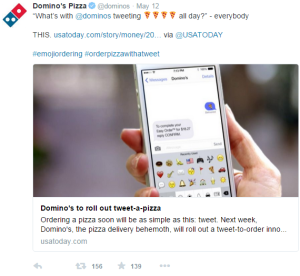
Results: Won this year’s Cannes Titanium Grand Prix. 500 users signed up on the first day
If you’re planning on using emojis in your brand communications, be sure to take a look at the full list of emoji characters from Unicode. The Unicode consortium is in charge of standardizing, approving, and offering guidelines for emojis. Through that chart you can preview how emojis appear in different platforms, which platforms support them, and their meanings (but be aware of your audience’s interpretation since they may be using those emojis differently than how Unicode defined them). Marketers are always searching for ways to stand out. Hopefully, emojis can help you make a stronger connection with your audience.
Emoji Tools
Here are some interesting analytical tools to help you speak emoji:
-
- Emojitracker counts global emoji usage on Twitter in real time to track and report popularity trends. According to Emojitracker, the most popular emoji characters on Twitter currently are:
-
- 1.
2.
3.
4.
5.
6.
7.
8.
9.
10.
- Silicon Feelings is an interactive world map, showing the locations of tweeted emojis in real time.
- 1.
This is the 3rd and final post in a 3-part series on Emojis. For more on emojis, be sure to check out:



